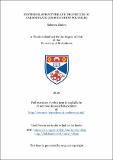Synthesis, structure and properties of carboxylate coordination polymers
View/
Date
03/12/2019Author
Supervisor
Funder
Grant ID
EP/K503162-1
Metadata
Show full item recordAbstract
The work in this thesis focuses on several coordination polymers, their crystal structures
and their potential applications as functional materials, in particular, their ferroelectric
and magnetic properties.
The mechanism of the known ferroelectric phase transition of (C₃NO₂H₇)₃CaCl₂ (TSCC)
was studied in detail using both X-ray and neutron diffraction data. The key structural
changes occurring in the vicinity of TC were identified in the Ca-O-C bond angles, which
change by up to 12˚. The structure of the compound was determined between 300 and
20 K to investigate potential phase transitions as suggested in the literature. The
diffraction data did not suggest an additional phase transition within this temperature
range. However, the detailed crystallographic studies did uncover new evidence of
ferrielectricity, which is consistent with electrical hysteresis data.
The origins of the ferroelectricity of TSCC were also probed through the synthesis and
characterisation of a range TSCC-related compounds which incorporated a range of
alternative halides and metal 2+ cations. Each compound formed coordination polymers
which were linked by sarcosine molecules, although the connectivity and structures
formed were dependent upon the composition. Whilst none of the TSCC derivatives had
ferroelectric properties, diffraction experiments were limited to a low temperature of
90 K and there could be additional phase transitions below this point.
A family of oxalate-based coordination polymers ALi₃M(C₂O₄)₃ with a perovskite-like
structures were also synthesised. The structural flexibility of these systems was
investigated through the incorporation of different A site cations and their magnetic
properties were investigated. Polyhedral distortions increase significantly upon the
inclusion of rubidium or caesium. Both KLi₃Co(C₂O₄)₃ and KLi₃Ni(C₂O₄)₃ have weak
antiferromagnetic exchange and μ[sub](eff) of 4.82 μ[sub]B and 3.62 μ[sub]B, respectively. The syntheses and structures of four new oxalate containing compounds, namely Rb₂Co(C₂O₄)₂.4H₂O,
Rb₂CoCl₂(C₂O₄), K₂Li₂Cu(C₂O₄)₃ and Li₄Co(C₂O₄)₃, which could have interesting magnetic
and electrochemical properties, are also reported.
Type
Thesis, PhD Doctor of Philosophy
Collections
Description of related resources
Synthesis, structure and properties of carboxylate coordination polymers (Thesis data) Clulow, R., University of St Andrews. DOI: https://doi.org/10.17630/000ddea9-f1d9-4ef7-b7e4-b57342d69fe4Related resources
https://doi.org/10.17630/000ddea9-f1d9-4ef7-b7e4-b57342d69fe4Items in the St Andrews Research Repository are protected by copyright, with all rights reserved, unless otherwise indicated.

